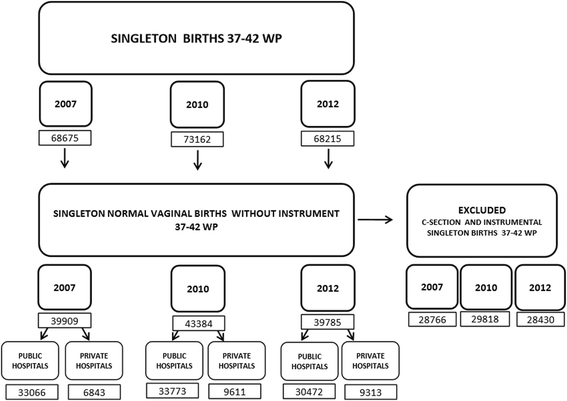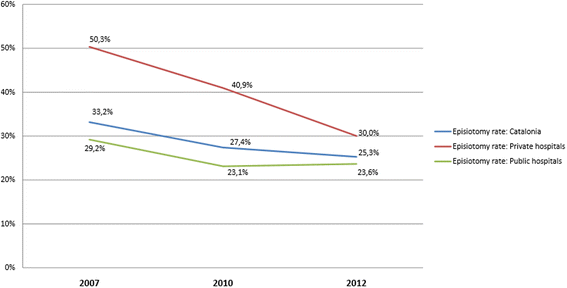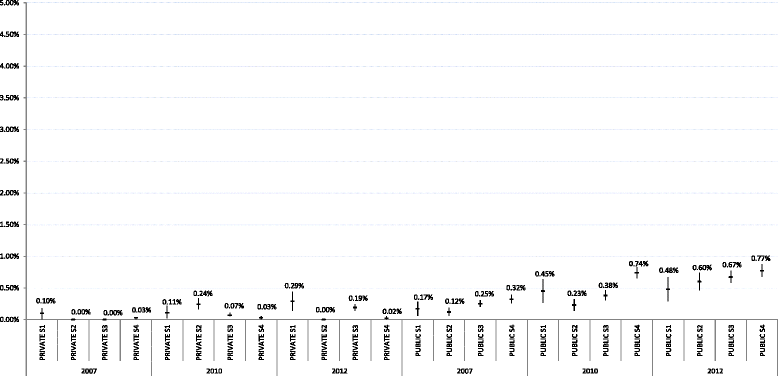Cross-sectional study comparing public and private hospitals in Catalonia: is the practice of routine episiotomy changing?
- PMID: 25889079
- PMCID: PMC4365515
- DOI: 10.1186/s12913-015-0753-z
Cross-sectional study comparing public and private hospitals in Catalonia: is the practice of routine episiotomy changing?
Abstract
Background: In Spain, the Strategy for Assistance in Normal Childbirth (SANC) promoted a model of care, which respects the physiological birth process and discards unnecessary routine interventions, such as episiotomies. We evaluated the rate of episiotomy use and perineal trauma as indicators of how selective introduction of the SANC initiative has impacted childbirth outcomes in hospitals of Catalonia.
Methods: Cross-sectional study of all singleton vaginal term deliveries without instrument registered in the Minimum Basic Data Set (MBDS) of Catalonia in 2007, 2010 and 2012. Hospitals were divided into types according to funding (public or private), and four strata were differentiated according to volume of births attended. Episiotomies and perineal injury were considered dependent variables. The relationship between qualitative variables was analysed using the chi-squared test, and Student's t-test was used for quantitative variables. Comparison of proportions was performed on the two hospital groups between 2007 and 2012 using a Z-test. Logistic regression models were used to analyse the relationship between episiotomy or severe perineal damage and maternal age, volume of births and hospital type, obtaining odds ratios (OR) and 95% confidence intervals (CI).
Results: The majority of normal singleton term deliveries were attended in public hospitals, where maternal age was lower than for women attended in private hospitals. Analysis revealed a statistically significant (P < 0.001) decreasing trend in episiotomy use in Catalonia for both hospital types. Private hospitals appeared to be associated with increased episiotomy rate in 2007 (OR = 1.099, CI: 1,057-1,142), 2010 (OR = 1.528, CI: 1,472-1,587) and 2012 (OR = 1.459, CI: 1,383-1,540), and a lower rate of severe perineal trauma in 2007 (OR = 0.164, CI: 0.095-0.283), 2010 (OR = 0.16, CI: 0.110-0.232) and 2012 (OR = 0.19, CI: 0.107-0.336). Regarding severe perineal injury, when independent variables were adjusted, maternal age ceased to have a significant correlation in 2012 (OR = 0.994, CI: 0.970-1.018).
Conclusions: Episiotomy procedures during normal singleton vaginal term deliveries in Catalonia has decreased steadily since 2007. Study results show a stable incidence trend below 1% for severe perineal trauma over the study period.
Figures




References
-
- DeLee JB, Chicago MD. The prophylactic forceps operation. Am J Obstet Gynecol. 1920;1:34–44. - PubMed
-
- Salinas H, Erazo M, PAstén J, Preisler J, Ide R, Carmona S, et al. Indicadores de calidad de asistencia obstétrica. Rev Chil Obstet Ginecol. 2006;71(2):114–20. doi: 10.4067/S0717-75262006000200007. - DOI
Publication types
MeSH terms
LinkOut - more resources
Full Text Sources
Medical

